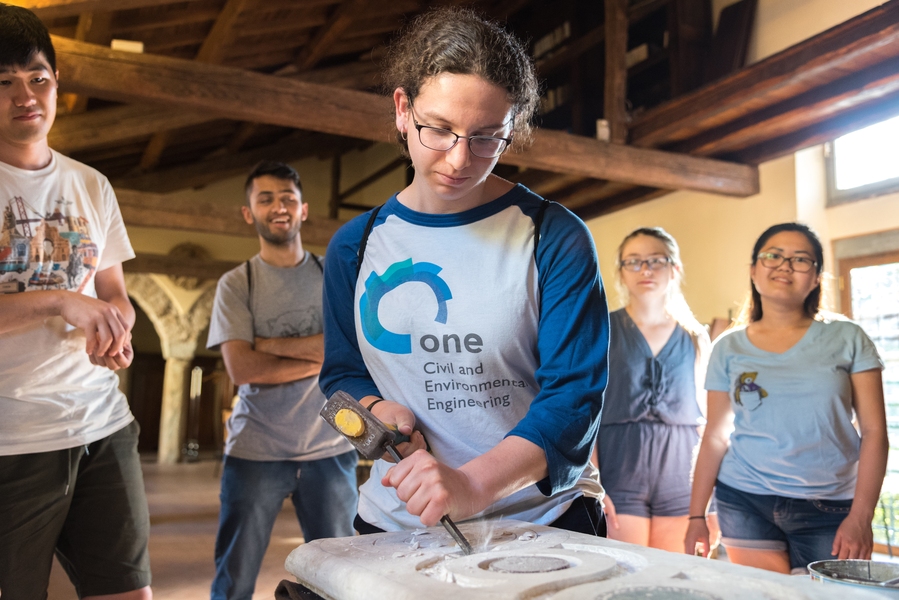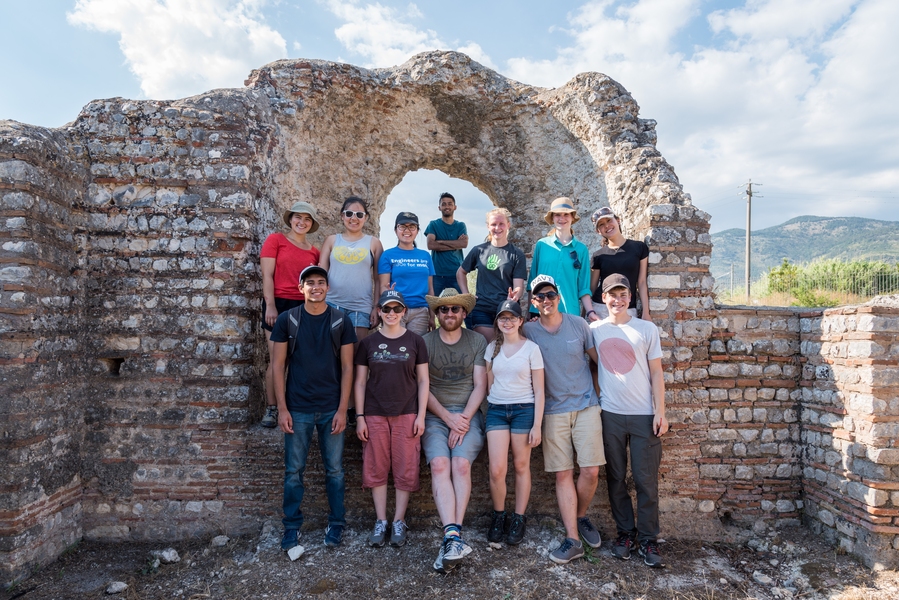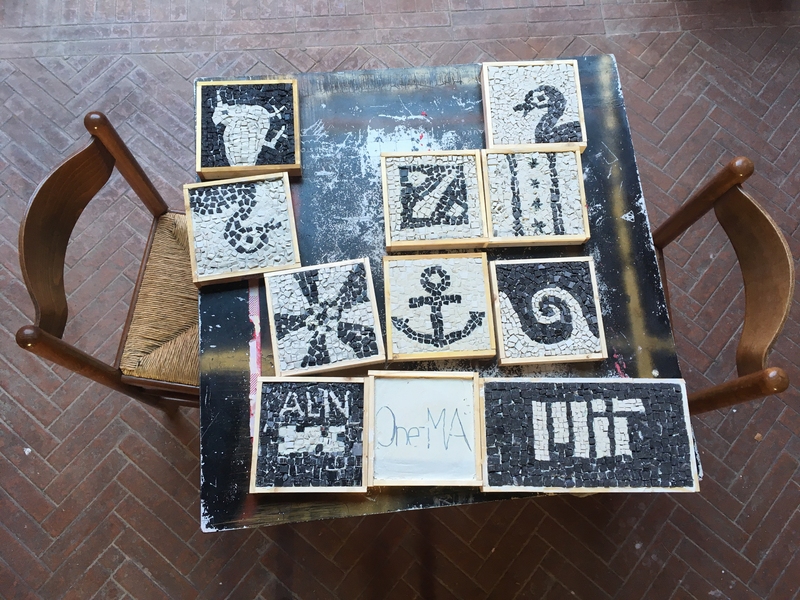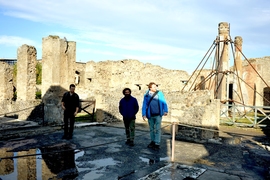Three-dimensional laser scanners and unpiloted aerial vehicles in hand, a group of MIT students walked through the Privernum archaeological site capturing information about degrading structures and newly-exposed mosaics in an effort to build digital models of how the site was constructed in its prime and design appropriate conservation strategies.
The exercise was one of many research opportunities afforded to students during the second annual program in Materials in Art, Archaeology and Architecture (ONE-MA3) between June 16 and July 5.
Hosted by the MIT Department of Civil and Environmental Engineering (CEE), ONE-MA3 exposes students to the remarkable methods and history of ancient engineers in Italy, while challenging them to consider how ancient successes could be used as building blocks for the development of new and innovative techniques, architectural structures, materials, and designs.
“In CEE, we engineer and create innovations to solve challenges identified from the world around us. We encourage our students to supplement their studies with fieldwork experiences like ONE-MA3,” says Markus Buehler, head of CEE and the McAfee Professor of Engineering. “By analyzing and evaluating our environment and the structures and materials that make up our world, such as those in Italy, we are able to identify opportunities for cutting-edge solutions for the future.”
During ONE-MA3, students explored Privernum, Rome, Pompeii, Turin, and Aramengo, stopping at archaeological sites, hearing from experts about their vocations and getting hands-on fieldwork experience. Led by Admir Masic, the Esther and Harold E. Edgerton Career Development Professor of CEE and founder of the program, and teaching assistants Linda Seymour and Chad Loh, the group approached cultural heritage from multiple perspectives, using ancient societies as examples of excellence in engineering that withstand the tests of time.
“ONE-MA3 transforms historical destinations into opportunities for learning and discovery. Knowing how to apply advanced technologies directly in the field allows us to learn more about ancient objects and structures, while injecting new meaning to these places,” Masic says. “Students are able to touch 2,000-years-old structures, study their design, and recreate their very resilient materials using original raw materials. I think it is crucial for students to immerse themselves in past cultures and see the impact their work can have on our world.”
Using the past as inspiration for the future
Critical to students’ understanding of the history, materials, and methods of ancient times is the ability to get direct hands-on experience working with archaeologists and curators to understand and learn about artifacts and both traditional and cutting-edge tools and techniques. To do this, students on ONE-MA3 were granted special access to restricted laboratories and areas of the ancient sites and museums that were not open to the public, including Pompeii and the Vatican.
In Privernum, the archaeological site located in what is now Priverno, the students used their unpiloted aerial vehicle, 3-D scanners, and thermal cameras to capture three-dimensional imagery to ultimately create a reconstruction of the site, useful for the study the interaction of this ancient infrastructure with the environment. While working in Privernum, the ONE-MA3 team also exposed and analyzed dirt-covered mosaics, taking photogrammetry of the patterns and artwork to later stitch the images together to visualize how they appeared inside dwellings during ancient times.
“My favorite part of the fieldwork was uncovering and analyzing the mosaics in Privernum,” said Sierra Rosenzweig, a rising sophomore majoring in CEE. “They were really beautiful and it felt like we were discovering clues to the past, even though some of them had been uncovered in the past and had been reburied at one point from wind.”
Students were also given the opportunity to create their own Roman mosaics and fresco paintings based on ancient methods and recipes learned and witnessed during ONE-MA3. Rosenzweig, for example, uncovered a mosaic with a unique wave design in Privernum, and was able to later recreate the design on a new mosaic using the same materials and methods as the ancient times.
Also in Privernum, the group learned from local experts how ancient Roman mortar was concocted and was given the opportunity to make some of their own. The experiment opened doors for students to consider how the ancient recipe could be a starting point for more durable and sustainable cement pastes for modern construction. For instance, the students were challenged to improve the mortar’s strength and the time it takes to set.
ONE-MA3 also took a few days to be tourists and explore Rome. While visiting the Vatican, the group was given exclusive access to the restricted restoration laboratories of the Vatican Museum. The labs conduct research and restoration, and gave students a firsthand look into the Vatican’s conservation efforts.
“We were given such an intimate view of the conservation that goes on in the Vatican. We were able to ask the professional restorers, conservators, and scientists whatever we wanted about everything they were showing us,” says Zoe Lallas, a rising sophomore in CEE. “We got to see artifacts in the middle of the restoration process, we got to look at artifacts that restorers had worked tirelessly for months conserving. Hearing them talk about their work was amazing. They were all so passionate about the individual pieces and their pride was palpable in their explanations.”
The group next traveled to Pompeii, where they learned about ongoing research projects at the archaeological site and were given private access to the Laboratory of Applied Research in Pompeii. In the lab and restricted areas of Pompeii, students learned about the methods for uncovering clues to the past, and how, for example, the research team uses satellite data to evaluate the movement of structures at the site over time. CEE Professor John Williams also joined ONE-MA3 in Pompeii, and spoke to the group about virtual reality and how cultural heritage could use technologies such as HoloLens to create compelling experiences.
While in Turin, the group toured royal residences and were given lectures on the architecture to put the tours into context. At the Castello di Valentino, historians from Polytechnic of Turin spoke to the group on the Baroque architecture, whereas at the Venaria Reale students learned about scientific monitoring of restoration projects. The students next visited the Palazzina di Caccia di Stupinigi, where they were granted special access to the castle, which allowed exploration of the different construction techniques and to see the roof structures.
“The group was in awe as we walked into the central room of the Palazzina where we saw the extravagant central chandelier and paintings on the ceiling. The conservation of the Palazzina was a remarkable feat that the whole group genuinely admired,” Rosenzweig recalled in a CEE blog on ONE-MA3.
The experience was not limited to Italian heritage, however. Also in Turin, the students visited the Egyptian Museum, where they heard from the museum’s director about their conservation and restoration methods. The group then toured the museum, which included admiring art, Egyptian sculptures, and mummies. The Egyptian culture allowed the students to compare ancient Egyptian techniques with those seen in Italian art and structures.
In Aramengo, a family that restores artwork greeted the group and led a discussion about their occupation and the different techniques they use when restoring art. The group was challenged with comparing these traditional methods with emerging methods learned elsewhere.
“The science of conserving art is particularly important because it gives us insight into historical context and culture. Everything from the colors they used and how they made them, to the materials the art was created on and how it interacts with and responds to the environment over time, can provide clues to their world and inspire future designs,” Masic says.
While the wide range of hands-on experiences, expert lectures and exclusive access tours and laboratory demonstrations provided insight and information, it was also a catalyst for a number of topics that students will pursue on campus in the upcoming fall semester. The annual occurrence of ONE-MA3 also opens the doors for future long-term collaborations and projects.
Bringing ancient Italy back to campus
ONE-MA3 is an exciting and travel-intensive few weeks, filled with a wealth of technical and cultural information. But the learning doesn’t stop in Italy: ONE-MA3 is a prerequisite for 1.057 (Heritage Science and Technology), where students will continue their research projects motivated by their Italian adventure.
“It injects new meaning to the class when we have a shared experience to reflect on,” Masic says. “We have found that students are more invested in the learning when they have been exposed to the topics in the real world and see the potential impact of their work.”
During the term, students will explore at greater depth the theory and practice behind cultural heritage, and relate what they experienced in Italy to their coursework and projects. Having been exposed to the concerns of cultural heritage practitioners on ONE-MA3, the students are tasked with formulating and designing projects that blend aspects of cultural heritage learned in Italy with current state-of-the-art science and engineering tools and methods.
“I think the combination of hands-on experiences and lectures during ONE-MA3 really helped the group think critically about ancient technologies and challenges conservationists face and how they could formulate projects to explore those areas,” Seymour says. “The project ideas for the fall that students suggested were incredibly diverse including conservation ethics, material design for modern structural applications and using virtual reality to bring our experience to people across the globe.”
The myriad of research topics afforded by ONE-MA3 exemplifies the interdisciplinary and wide-ranging nature of the experience. Each student brought his or her own unique interests to ONE-MA3, greatly diversifying the scope of the upcoming class projects.
“At the end of the trip we had a quick discussion about our coming projects in the fall. The variance of topics that arose is kind of crazy seeing as we were all on the same trip and learned the same things,” Lallas says. “But it seems like it should make for a very exciting semester.”









